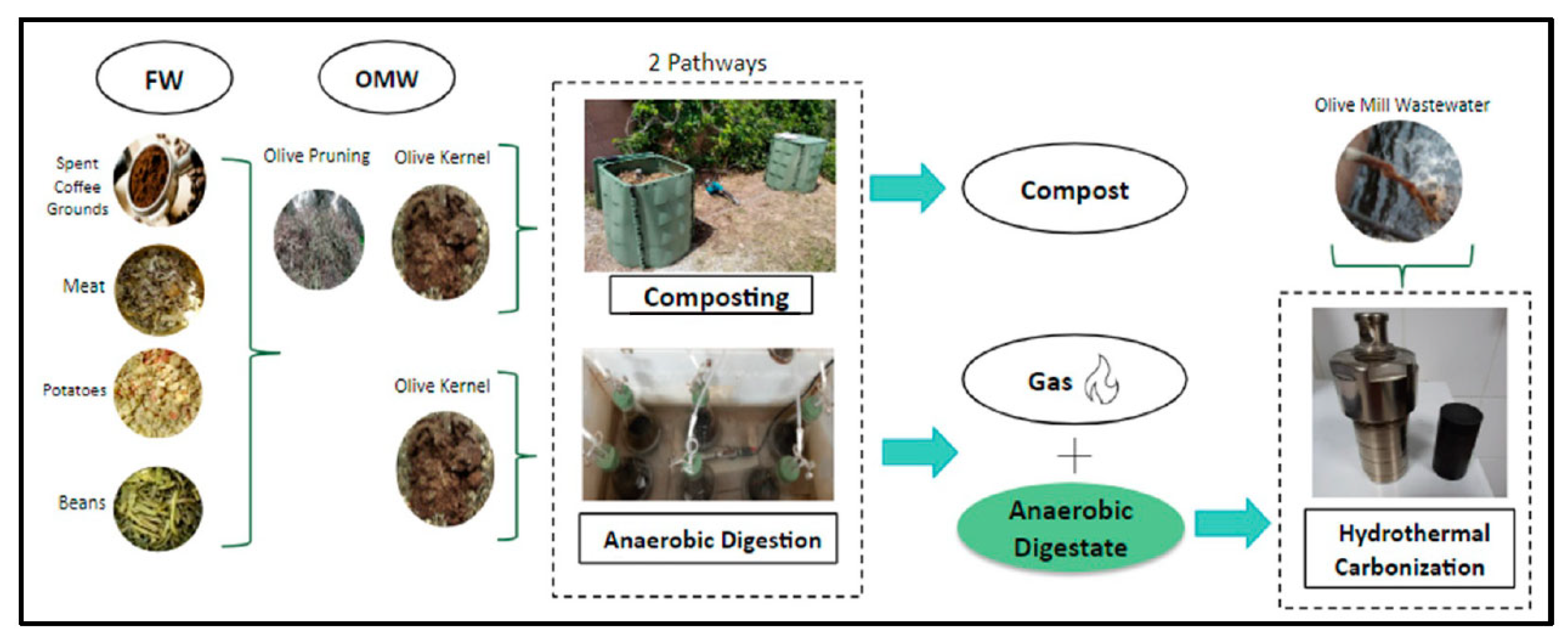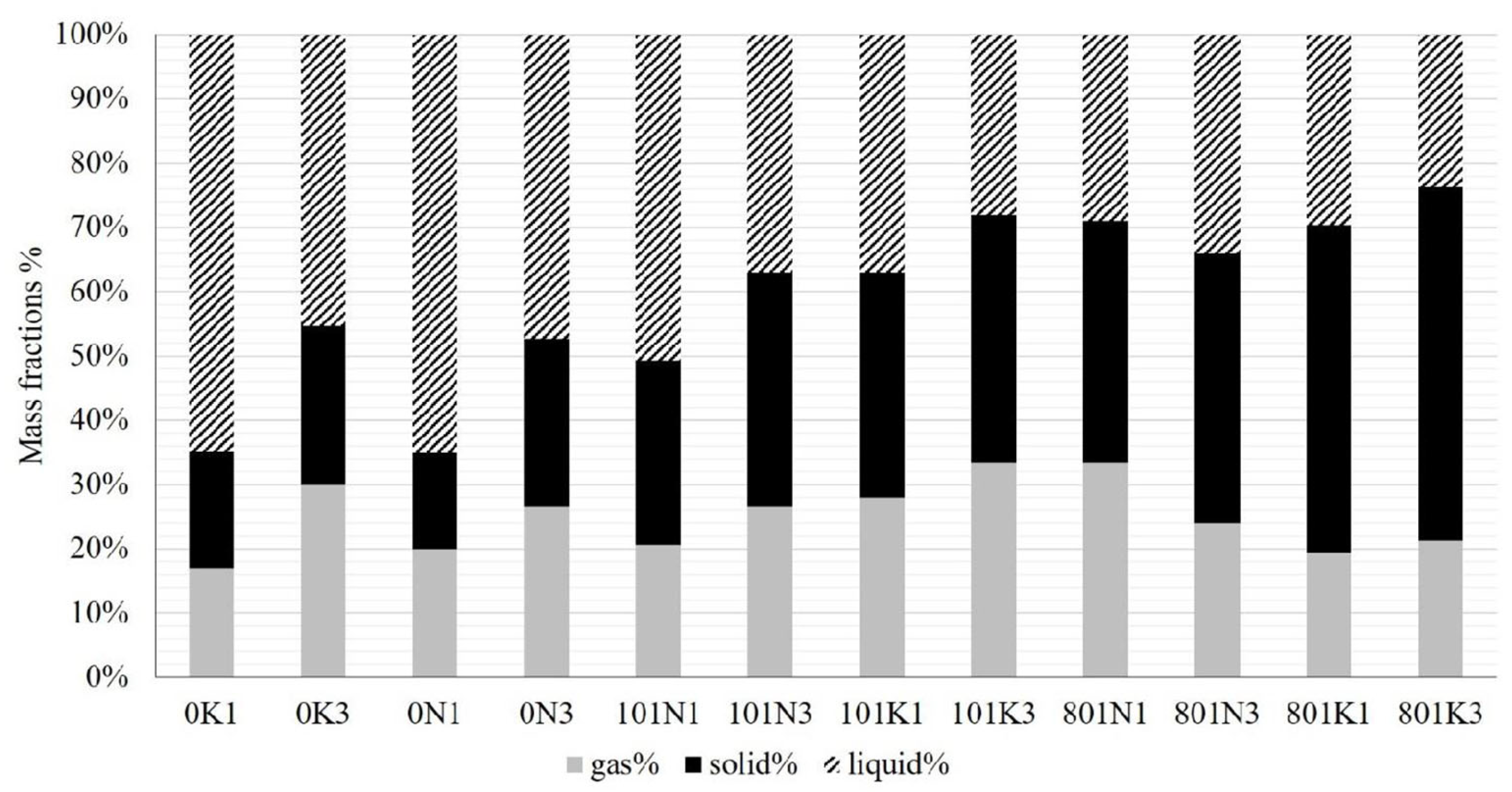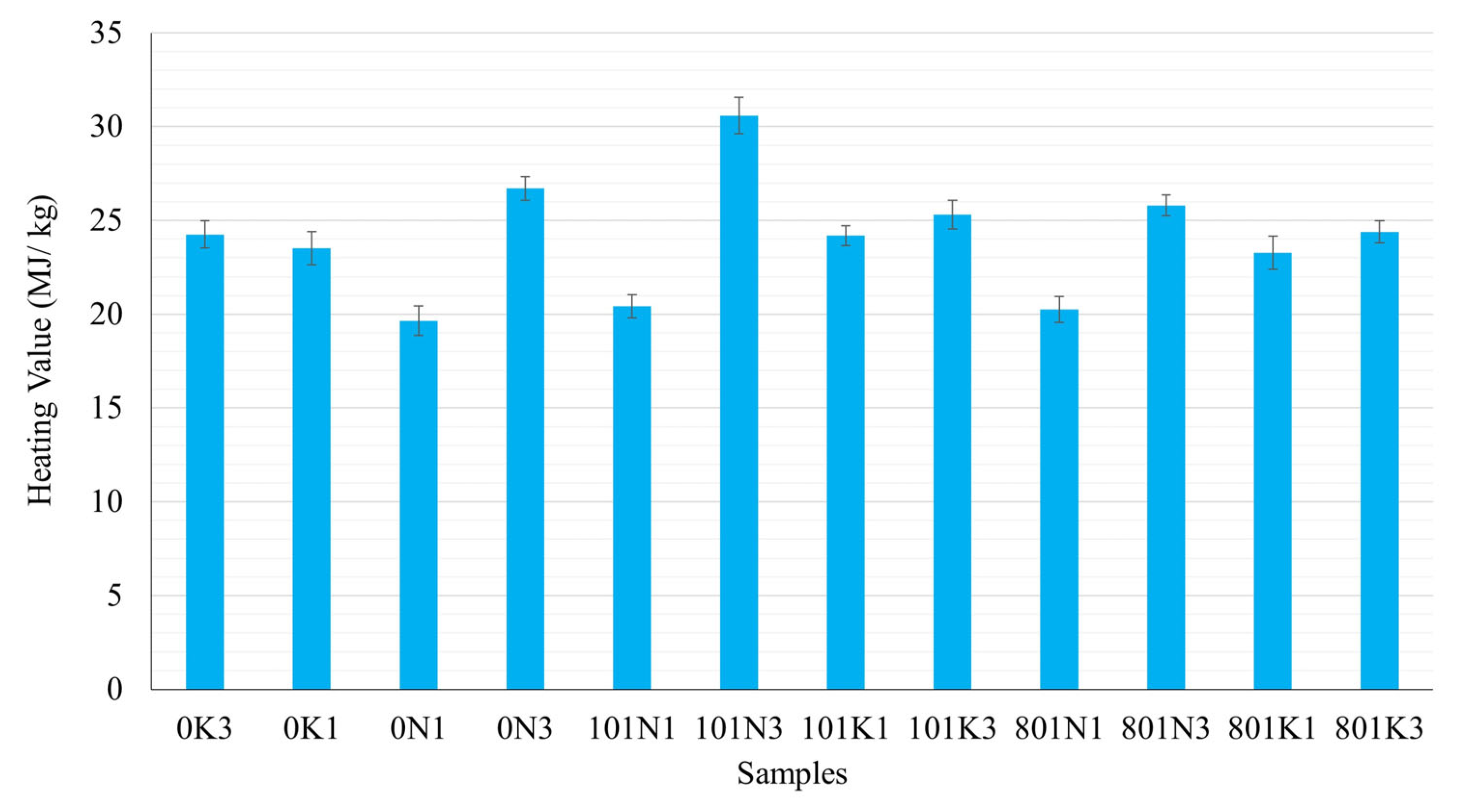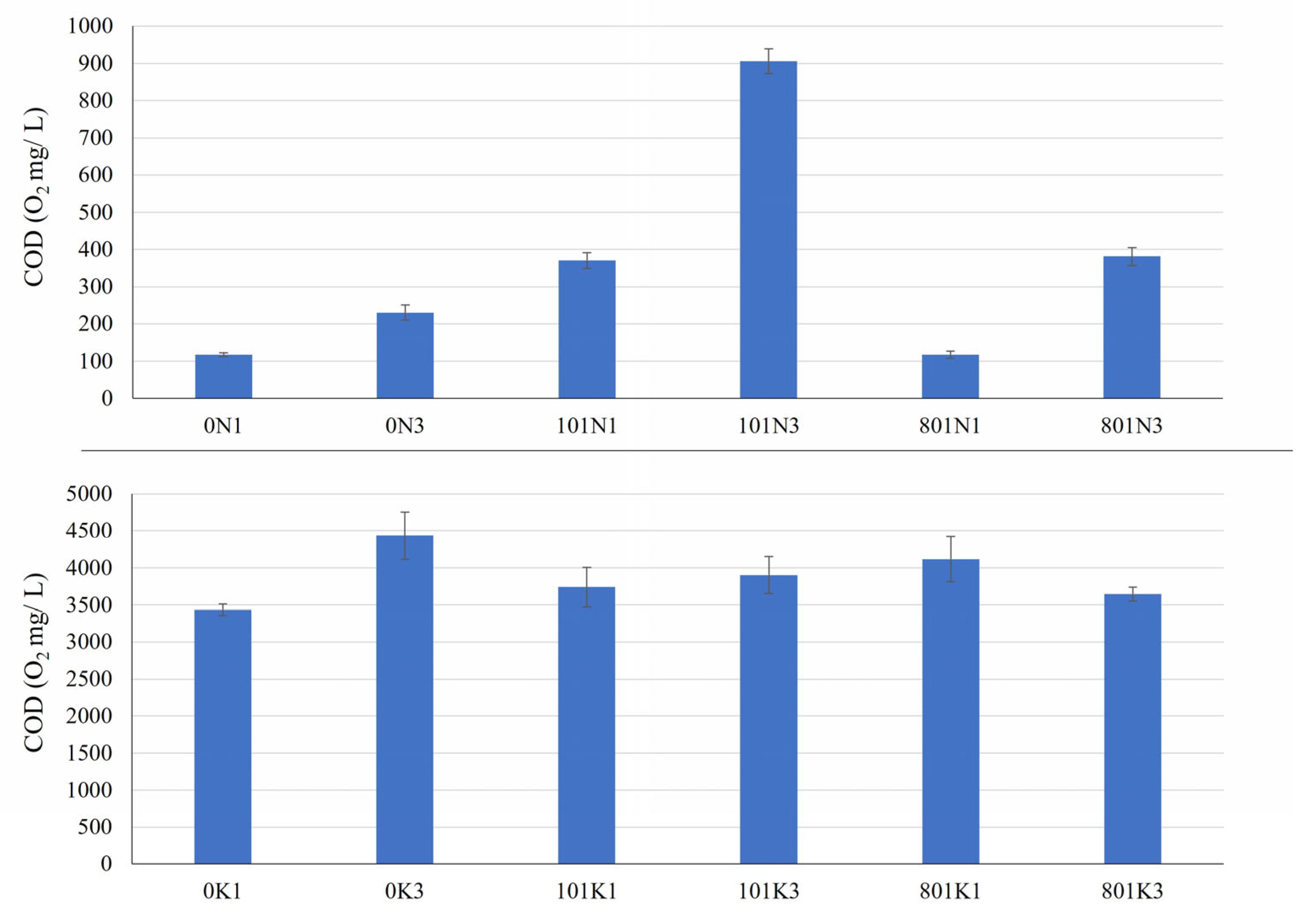Hydrothermal Carbonization of Dry Anaerobic Digestion Residues Derived from Food and Agro Wastes in Lesvos Island
Abstract
1. Introduction
2. Materials and Methods
2.1. Waste Valorization Technologies
2.1.1. Composting
2.1.2. Anaerobic Digestion
- ➢
- 1 g of digestate (all the available samples);
- ➢
- 8 mL H2O or 8 mL olive mill wastewater.
3. Results
3.1. Composting
3.2. Anaerobic Digestion
3.3. Hydrothermal Carbonisation
4. Discussion
5. Conclusions
Author Contributions
Funding
Data Availability Statement
Conflicts of Interest
References
- European Commission. Communication from the Commission to the European Parliament, the Council, the European Economic and Social Committee and the Committee of the Regions Closing the Loop—An EU Action Plan for the Circular Economy COM/2015/0614 Final. EUROSTAT.2020. Agri-Environmental Indicators. 2015. Available online: https://ec.europa.eu/eurostat/data/ (accessed on 15 April 2023).
- Vakalis, S.; Moustakas, K.; Benedetti, V.; Cordioli, E.; Patuzzi, F.; Loizidou, M.; Baratieri, M. The “COFFEE BIN” concept: Centralized collection scheme and torrefaction of spent coffee grounds—An introduction to the concept of the “COFFEE BIN”. Environ. Sci. Pollut. Res. 2019, 26, 35473–35481. [Google Scholar] [CrossRef]
- Loizidou, M.; Vakalis, S.; Moustakas, K.; Malamis, D. Chapter 5—Movement Towards Circular Economy and EU. Waste Management Regulation. In Proceedings of the 2018 EEC/WTERT Conference, New York, NY, USA, 4–5 October 2018; Marco, J.C., Francesco, P., Simona, C., Swanand, T., Demetra, T., Eds.; ASME: New York, NY, USA, 2019. ISBN 9780791861950. [Google Scholar] [CrossRef]
- Ojha, S.; Sara, B.S.; Schlüter, O.K. Food waste valorisation and circular economy concepts in insect production and processing. Waste Manag. 2020, 118, 600–609. [Google Scholar] [CrossRef]
- Pérez, S.; Renedo, C.; Ortiz, A.; Mañana, M.; Delgado, F.; Tejedor, C. Energetic density of different forest species of energy crops in Cantabria (Spain). Biomass-Bioenergy 2011, 359, 4657–4664. [Google Scholar] [CrossRef]
- Castaldi, M.J. The Scientific Truth about Waste-to-Energy. Grove School of Engineering, City College of New York: New York, NY, USA, 2021. Available online: https://ccnyeec.org/wp-content/uploads/2021/05/WTE-REPORT7603.pdf (accessed on 15 April 2023).
- Regional Authority of North Aegean. Strategic and Operational Program of the Municipality of Lesvos 2015–2019. 2015. Available online: http://www.mytilene.gr/wp403content/uploads/2016/09/Epixirisiako_sxedio.pdf (accessed on 15 April 2023).
- Moustakas, K.; Parmaxidou, P.; Vakalis, S. Anaerobic digestion for energy production from agricultural biomass waste in Greece: Capacity assessment for the region of Thessaly. Energy 2019, 191, 116556. [Google Scholar] [CrossRef]
- European Commision. Updated Bioeconomy Strategy: A Sustainable Bioeconomy for Europe: Strengthening the Connection between Economy, Society and the Environment, Directorate-General for Research and Innovation Unit F—Bioeconomy; European Commission B-1049 Brussels: Brussels, Belgium, 2018; ISBN 978-92-79-94144-3.
- Katsouli, A.; Stasinakis, A.S. Production of municipal solid waste and sewage in European refugees’ camps: The case of Lesvos, Greece. Waste Manag. 2019, 86, 49–53. [Google Scholar] [CrossRef] [PubMed]
- Porzig, M.; Baur, F.; Wern, B.; Lekkas, D.D.F. SusNisia: Circular economy for biogenic residues for the North Aegean—Case studies for Islands of Chios and Lesvos. In Proceedings of the 16th International Conference on Environmental Science and Technology, Rhodes, Greece, 4–7 September 2019. [Google Scholar]
- Gilbert, J.; Ricci-Jürgensen, M.; Ramola, A. Benefits of Compost and Anaerobic Digestate When Applied to Soil. Report ISWA. 2020. Available online: https://www.altereko.it/wp-content/uploads/2020/03/Report-2-Benefits-of-Compost-and-Anaerobic-Digestate.pdf (accessed on 11 December 2021).
- Mak, T.M.W.; Xiong, X.; Tsang, D.C.W.; Yu, I.K.M.; Poon, C.S. Sustainable Food Waste Management towards Circular Bioeconomy: Policy Review, Limitations and Opportunities. In Bioresource Technology; Elsevier Ltd.: Amsterdam, The Netherlands, 2020. [Google Scholar]
- Guo, X.-H.; Sun, F.; Sun, Y.-J.; Lu, H.-H.; Wu, W.-X. Characterization and energy potential of food waste from catering service in Hangzhou, China. Waste Manag. Res. 2014, 32, 791–795. [Google Scholar] [CrossRef]
- Dahdouh, A.; Khay, I.; Le Brech, Y.; El Maakoul, A.; Bakhouya, M. Olive oil industry: A review of waste stream composition, environmental impacts, and energy valorization paths. Environ. Sci. Pollut. Res. 2023, 30, 16. [Google Scholar] [CrossRef]
- Czekała, W.; Malińska, K.; Cáceres, R.; Janczak, D.; Dach, J.; Lewicki, A. Co-composting of poultry manure mixtures amended with biochar—The effect of biochar on temperature and C-CO2 emission. Bioresour. Technol. 2016, 200, 921–927. [Google Scholar] [CrossRef]
- Atabani, A.; Al-Muhtaseb, A.H.; Kumar, G.; Saratale, G.D.; Aslam, M.; Khan, H.A.; Said, Z.; Mahmoud, E. Valorization of spent coffee grounds into biofuels and value-added products: Pathway towards integrated bio-refinery. Fuel 2019, 254, 115640. [Google Scholar] [CrossRef]
- Gebreeyessus, G.D. Towards the sustainable and circular bioeconomy: Insights on spent coffee grounds valorization. Sci. Total Environ. 2022, 833, 155113. [Google Scholar] [CrossRef]
- Lee, Y.-G.; Cho, E.-J.; Maskey, S.; Nguyen, D.-T.; Bae, H.-J. Value-Added Products from Coffee Waste: A Review. Molecules 2023, 28, 3562. [Google Scholar] [CrossRef]
- Al Seadi, T.; Owen, N.; Hellström, H.; Kang, H. Source Separation of MSW: An Overview of the Source Separation and Separate Collection of the Digestible Fraction of Household Waste, and of Other Similar Wastes from Municipalities, Aimed to Be Used as Feedstock for Anaerobic Digestion in Biogas Plants; IEA Bioenergy: Paris, France, 2013; ISBN 978-1-910154-01-4. [Google Scholar]
- Negri, C.; Ricci, M.; Zilio, M.; D’Imporzano, G.; Qiao, W.; Dong, R.; Adani, F. Anaerobic digestion of food waste for bio-energy production in China and Southeast Asia: A review. Renew. Sustain. Energy Rev. 2020, 133, 110138. [Google Scholar] [CrossRef]
- Angelidaki, I.; Treu, L.; Tsapekos, P.; Luo, G.; Campanaro, S.; Wenzel, H.; Kougias, P.G. Biogas upgrading and utilization: Current status and perspectives. Biotechnol. Adv. 2018, 36, 452–466. [Google Scholar] [CrossRef] [PubMed]
- Liu, J.; Zhao, M.; Lv, C.; Yue, P. The effect of microwave pretreatment on anaerobic co-digestion of sludge and food waste: Performance, kinetics and energy recovery. Environ. Res. 2020, 189, 109856. [Google Scholar] [CrossRef]
- Zhang, L.; Kuroki, A.; Loh, K.-C.; Seok, J.K.; Dai, Y.; Tong, Y.W. Highly efficient anaerobic co-digestion of food waste and horticultural waste using a three-stage thermophilic bioreactor: Performance evaluation, microbial community analysis, and energy balance assessment. Energy Convers. Manag. 2020, 223, 113290. [Google Scholar] [CrossRef]
- Yuan, T.; Shi, X.; Sun, R.; Ko, J.H.; Xu, Q. Simultaneous addition of biochar and zero-valent iron to improve food waste anaerobic digestion. J. Clean. Prod. 2020, 278, 123627. [Google Scholar] [CrossRef]
- Vakalis, S.; Ahmad, J.; Heimann, R.; Patuzzi, F.; Baratieri, M. The Case of Frictional Torrefaction and the Effect of Reflux Condensation on the Operation of the Rotary Compression Unit. Bioresour. Technol. 2018, 268, 91–96. [Google Scholar] [CrossRef]
- Libra, J.A.; Ro, K.S.; Kammann, C.; Funke, A.; Berge, N.D.; Neubauer, Y.; Titirici, M.-M.; Fühner, C.; Bens, O.; Kern, J.; et al. Hydrothermal carbonization of biomass residuals: A comparative review of the chemistry, processes and applications of wet and dry pyrolysis. Biofuels 2011, 2, 71–106. [Google Scholar] [CrossRef]
- Su, H.; Zhou, X.; Zheng, R.; Zhou, Z.; Zhang, Y.; Zhu, G.; Yu, C.; Hantoko, D.; Yan, M. Hydrothermal carbonization of food waste after oil extraction pre-treatment: Study on hydrochar fuel characteristics, combustion behavior, and removal behavior of sodium and potassium. Sci. Total Environ. 2020, 754, 142192. [Google Scholar] [CrossRef] [PubMed]
- Sharma, H.B.; Dubey, B.K. Co-hydrothermal carbonization of food waste with yard waste for solid biofuel production: Hydrochar characterization and its pelletization. Waste Manag. 2020, 118, 521–533. [Google Scholar] [CrossRef] [PubMed]
- Pawlak-Kruczek, H.; Niedzwiecki, L.; Sieradzka, M.; Mlonka-Mędrala, A.; Baranowski, M.; Serafin-Tkaczuk, M.; Magdziarz, A. Hydrothermal carbonization of agricultural and municipal solid waste digestates—Structure and energetic properties of the solid products. Fuel 2020, 275, 117837. [Google Scholar] [CrossRef]
- Anca-Couce, A.; Bruno, J.C.; Sharifi, V.; Fraga, E.S. A comprehensive review on the hydrothermal carbonization of biomass: Process, design, and characterization. Bioresour. Technol. 2019, 281, 449–469. [Google Scholar]
- Xu, X.; Liu, G.; Li, L.; Huang, L.; Chen, C.; Chen, S. Influence of hydrothermal carbonization process on hydrochar properties and its applications: A review. Energy Convers. Manag. 2020, 213, 112812. [Google Scholar]
- Titirici, M.M.; Falco, C.; Sevilla, M. Tailoring the porous properties of carbon materials by the use of templating agents. Chem. Soc. Rev. 2015, 44, 250–290. [Google Scholar] [CrossRef] [PubMed]
- Kapoor, R.; Ghosh, P.; Tyagi, B.; Vijay, V.K.; Vijay, V.; Thakur, I.S.; Kamyab, H.; Nguyen, D.D.; Kumar, A. Advances in biogas valorization and utilization systems: A comprehensive review. J. Clean. Prod. 2020, 273, 123052. [Google Scholar] [CrossRef]
- Shrestha, A.; Acharya, B.; Farooque, A.A. Study of hydrochar and process water from hydrothermal carbonization of sea lettuce. Renew. Energy 2020, 163, 589–598. [Google Scholar] [CrossRef]
- Zhang, S.; Sheng, K.; Yan, W.; Liu, J.; Shuang, E.; Yang, M.; Zhang, X. Bamboo derived hydrochar microspheres fabricated by acid-assisted hydrothermal carbonization. Chemosphere 2021, 263, 128093. [Google Scholar] [CrossRef]
- Zhang, X.; Tian, Y.; Zuo, Y.; Yan, Z.; Hu, B. Characterization of hydrochar from hydrothermal carbonization of biomass: A review. J. Energy Chem. 2017, 26, 639–652. [Google Scholar]
- Chen, X.; Geng, P.; Qiao, W.; Chen, S. Effects of reaction temperature and residence time on the physicochemical properties of hydrothermal carbonization liquor. Bioresour. Technol. 2018, 247, 502–509. [Google Scholar]
- Wu, Y.; Pan, W.; Huang, W.; Huang, Z.; Chen, D.; Huang, H. Compositional changes and evolution of functional groups in hydrothermal carbonization liquor of corn stover. Ind. Crops Prod. 2020, 150, 112433. [Google Scholar]







| Beans | Potatoes | Chicken | Olive Branches | Biphasic Olive Mill Kernel | OMWW | SCG | |
|---|---|---|---|---|---|---|---|
| pH | 6.53 ± 0.03 | 4.85 ± 0.02 | 6.86 ± 0.03 | 5.66 ± 0.02 | 4.98 ± 0.01 | 4.6 ± 0.01 | 6.3 ± 0.01 |
| Moist. (%) | 83.78 ± 1.20 | 82.75 ± 1.75 | 57.44 ± 2.63 | 9.99 ± 2.1 | 51.42 ± 0.81 | 93.3 ± 1.15 | 66.52 ± 2.30 |
| TS (%) | 16.22 ± 1.43 | 17.25 ± 1.34 | 42.56 ± 2.76 | 90.01 ± 1.94 | 48.58 ± 1.87 | 6.7 ± 1.06 | 33.4 ± 2.3 |
| VS (%) | 11.35 ± 1.90 | 13.80 ± 1.76 | 27.66 ± 1.69 | 72 ± 2.01 | 24.29 ± 1.08 | 6.5 ± 1.72 | 14.7 ± 2.5 |
| TOC (%) | 48.4 ± 1.53 | 50.45 ± 1.78 | 53 ± 1. 89 | 28.95 ± 0.88 | 53.1 ± 0.76 | 3.3 ± 0.06 | 42.5 ± 0.19 |
| TN (%) | 5.07 ± 0.71 | 1.42 ± 0.34 | 8.02 ± 0.67 | 1.03 ± 0.05 | 0.83 ± 0.13 | nd | 2.6 ± 0.11 |
| C/N ratio | 19.09 | 35.63 | 6.61 | 28.35 | 64.2 | nd | 16.4 |
| K1 | K2 | |||
|---|---|---|---|---|
| kg | % w/w (avg.) | kg | % w/w (avg.) | |
| Meat | 16.7 ± 0.82 | 7.8 | 14.1 ± 0.23 | 6.56 |
| Beans | 25.5 ± 0.76 | 11.8 | 21.6 ± 0.63 | 10 |
| Potatoes | 154 ± 1.53 | 71.3 | 131 ± 1.04 | 60.7 |
| Biphasic Olive Mill Kernel | 0 | 0 | 29.3 ± 2.13 | 13.6 |
| Brunches | 21.5 ± 1.18 | 10 | 21.5 ± 1.13 | 10 |
| Total Food (avg.) | 196.2 | 90.9 | 196 | 90.86 |
| Total Material (avg.) | 217.7 | 100.9 | 217.5 | 100.86 |
| Sample ID | Sludge | Food Waste | SCG |
|---|---|---|---|
| 0 | 350 g | 0% | 0% |
| FW80 | 350 g | 80% | 20% |
| FW100 | 350 g | 100% | 0% |
| Sample ID | Mixture |
|---|---|
| 0K1 | Sludge/OMWW (1 day of HTC) |
| 0K3 | Sludge/OMWW (3 days of HTC) |
| 0N1 | Sludge/Water (1 day of HTC) |
| 0N3 | Sludge/Water (3 day of HTC) |
| 101N1 | Sludge + FW/Water (1 day of HTC) |
| 101N3 | Sludge + FW/Water (3 day of HTC) |
| 101K1 | Sludge + FW/OMWW (1 day of HTC) |
| 101K3 | Sludge + FW/OMWW (3 day of HTC) |
| 801N1 | Sludge + FW (80%) + SPG (20%)/Water (1 day of HTC) |
| 801N3 | Sludge + FW (80%) + SPG (20%)/Water (3 day of HTC) |
| 801K1 | Sludge + FW (80%) + SPG (20%)/OMWW (1 day of HTC) |
| 801K3 | Sludge + FW (80%) + SPG (20%)/OMWW (3 day of HTC) |
Disclaimer/Publisher’s Note: The statements, opinions and data contained in all publications are solely those of the individual author(s) and contributor(s) and not of MDPI and/or the editor(s). MDPI and/or the editor(s) disclaim responsibility for any injury to people or property resulting from any ideas, methods, instructions or products referred to in the content. |
© 2023 by the authors. Licensee MDPI, Basel, Switzerland. This article is an open access article distributed under the terms and conditions of the Creative Commons Attribution (CC BY) license (https://creativecommons.org/licenses/by/4.0/).
Share and Cite
Xypolias, P.; Vakalis, S.; Daskaloudis, I.; Lekkas, D.F. Hydrothermal Carbonization of Dry Anaerobic Digestion Residues Derived from Food and Agro Wastes in Lesvos Island. Energies 2023, 16, 4619. https://doi.org/10.3390/en16124619
Xypolias P, Vakalis S, Daskaloudis I, Lekkas DF. Hydrothermal Carbonization of Dry Anaerobic Digestion Residues Derived from Food and Agro Wastes in Lesvos Island. Energies. 2023; 16(12):4619. https://doi.org/10.3390/en16124619
Chicago/Turabian StyleXypolias, Panagiotis, Stergios Vakalis, Ioannis Daskaloudis, and Dimitrios Francis Lekkas. 2023. "Hydrothermal Carbonization of Dry Anaerobic Digestion Residues Derived from Food and Agro Wastes in Lesvos Island" Energies 16, no. 12: 4619. https://doi.org/10.3390/en16124619
APA StyleXypolias, P., Vakalis, S., Daskaloudis, I., & Lekkas, D. F. (2023). Hydrothermal Carbonization of Dry Anaerobic Digestion Residues Derived from Food and Agro Wastes in Lesvos Island. Energies, 16(12), 4619. https://doi.org/10.3390/en16124619









